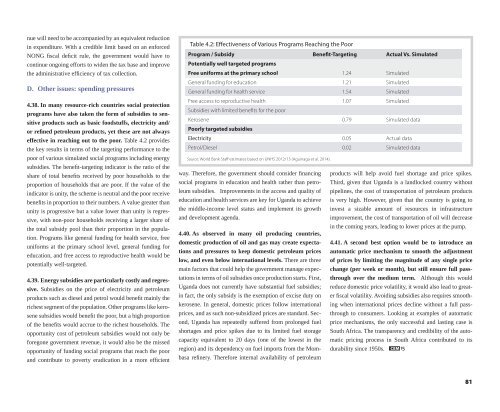Economic Diversification and Growth
71mK301zeG0
71mK301zeG0
Create successful ePaper yourself
Turn your PDF publications into a flip-book with our unique Google optimized e-Paper software.
nue will need to be accompanied by an equivalent reduction<br />
in expenditure. With a credible limit based on an enforced<br />
NONG fiscal deficit rule, the government would have to<br />
continue ongoing efforts to widen the tax base <strong>and</strong> improve<br />
the administrative efficiency of tax collection.<br />
D. Other issues: spending pressures<br />
4.38. In many resource-rich countries social protection<br />
programs have also taken the form of subsidies to sensitive<br />
products such as basic foodstuffs, electricity <strong>and</strong>/<br />
or refined petroleum products, yet these are not always<br />
effective in reaching out to the poor. Table 4.2 provides<br />
the key results in terms of the targeting performance to the<br />
poor of various simulated social programs including energy<br />
subsidies. The benefit-targeting indicator is the ratio of the<br />
share of total benefits received by poor households to the<br />
proportion of households that are poor. If the value of the<br />
indicator is unity, the scheme is neutral <strong>and</strong> the poor receive<br />
benefits in proportion to their numbers. A value greater than<br />
unity is progressive but a value lower than unity is regressive,<br />
with non-poor households receiving a larger share of<br />
the total subsidy pool than their proportion in the population.<br />
Programs like general funding for health service, free<br />
uniforms at the primary school level, general funding for<br />
education, <strong>and</strong> free access to reproductive health would be<br />
potentially well-targeted.<br />
4.39. Energy subsidies are particularly costly <strong>and</strong> regressive.<br />
Subsidies on the price of electricity <strong>and</strong> petroleum<br />
products such as diesel <strong>and</strong> petrol would benefit mainly the<br />
richest segment of the population. Other programs like kerosene<br />
subsidies would benefit the poor, but a high proportion<br />
of the benefits would accrue to the richest households. The<br />
opportunity cost of petroleum subsidies would not only be<br />
foregone government revenue, it would also be the missed<br />
opportunity of funding social programs that reach the poor<br />
<strong>and</strong> contribute to poverty eradication in a more efficient<br />
Table 4.2: Effectiveness of Various Programs Reaching the Poor<br />
Program / Subsidy Benefit-Targeting Actual Vs. Simulated<br />
Potentially well targeted programs<br />
Free uniforms at the primary school 1.24 Simulated<br />
General funding for education 1.21 Simulated<br />
General funding for health service 1.54 Simulated<br />
Free access to reproductive health 1.07 Simulated<br />
Subsidies with limited benefits for the poor<br />
Kerosene 0.79 Simulated data<br />
Poorly targeted subsidies<br />
Electricity 0.05 Actual data<br />
Petrol/Diesel 0.02 Simulated data<br />
Source: World Bank Staff estimates based on UNHS 2012/13 (Aguinaga et al. 2014).<br />
way. Therefore, the government should consider financing<br />
social programs in education <strong>and</strong> health rather than petroleum<br />
subsidies. Improvements in the access <strong>and</strong> quality of<br />
education <strong>and</strong> health services are key for Ug<strong>and</strong>a to achieve<br />
the middle-income level status <strong>and</strong> implement its growth<br />
<strong>and</strong> development agenda.<br />
products will help avoid fuel shortage <strong>and</strong> price spikes.<br />
Third, given that Ug<strong>and</strong>a is a l<strong>and</strong>locked country without<br />
pipelines, the cost of transportation of petroleum products<br />
is very high. However, given that the country is going to<br />
invest a sizable amount of resources in infrastructure<br />
improvement, the cost of transportation of oil will decrease<br />
in the coming years, leading to lower prices at the pump.<br />
4.40. As observed in many oil producing countries,<br />
domestic production of oil <strong>and</strong> gas may create expectations<br />
<strong>and</strong> pressures to keep domestic petroleum prices<br />
low, <strong>and</strong> even below international levels. There are three<br />
main factors that could help the government manage expectations<br />
in terms of oil subsidies once production starts. First,<br />
Ug<strong>and</strong>a does not currently have substantial fuel subsidies;<br />
in fact, the only subsidy is the exemption of excise duty on<br />
kerosene. In general, domestic prices follow international<br />
prices, <strong>and</strong> as such non-subsidized prices are st<strong>and</strong>ard. Second,<br />
Ug<strong>and</strong>a has repeatedly suffered from prolonged fuel<br />
shortages <strong>and</strong> price spikes due to its limited fuel storage<br />
capacity equivalent to 20 days (one of the lowest in the<br />
region) <strong>and</strong> its dependency on fuel imports from the Mombasa<br />
4.41. A second best option would be to introduce an<br />
automatic price mechanism to smooth the adjustment<br />
of prices by limiting the magnitude of any single price<br />
change (per week or month), but still ensure full passthrough<br />
over the medium term. Although this would<br />
reduce domestic price volatility, it would also lead to greater<br />
fiscal volatility. Avoiding subsidies also requires smoothing<br />
when international prices decline without a full passthrough<br />
to consumers. Looking at examples of automatic<br />
price mechanisms, the only successful <strong>and</strong> lasting case is<br />
South Africa. The transparency <strong>and</strong> credibility of the automatic<br />
pricing process in South Africa contributed to its<br />
durability since 1950s.<br />
refinery. Therefore internal availability of<br />
petroleum<br />
81


